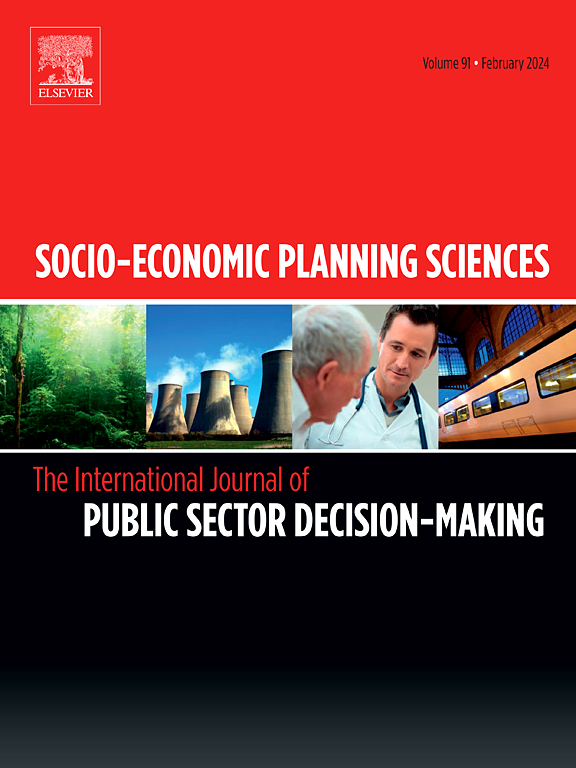Collaborate or compete? Decentralized resource allocation between local authorities during COVID-19 based on evolutionary game theory
IF 5.4
2区 经济学
Q1 ECONOMICS
引用次数: 0
Abstract
Facing the threaten of world-wide pandemics such as COVID-19, critical resources including masks, vaccines, and medical equipment play an important role in infection risk mitigation and outbreak containment. However, with limited market resources, as it is hard to satisfy all the demands, a natural question is that how to make the allocation? Given the complicated and varying situation, this paper models the interaction between two local authorities making resource allocation decisions within the background of epidemic following the methodology of evolutionary game theory. The proposed model can be applied to practical resource allocation determinations on examining how critical factors influence allocation outcomes and offering strategic insights on whether local authorities should adopt collaborative or competitive approaches under varying conditions. A case study along with the sensitivity analysis based on the real-world background is further constructed to prove the feasibility and efficiency of this model. The results indicate that while collaboration is generally a better strategy in most situations, competition may emerge when potential benefits outweigh cooperation incentives—particularly depending on pandemic severity and transmission rates. Interestingly, both excessively high and relatively low severity levels, as well as external impacts, can trigger competitive behavior. The novelty of this study lies in providing a strategic tool that helps solve a practical resource allocation problem considering the dynamic characteristic of COVID-19. This paper illustrates managerial insights on reminding the decision-makers that extra efforts may need to promote a demand-driven resource allocation (the one with higher demand gets more resources) in the fast-spread and emergency stage of a pandemic.
合作还是竞争?基于进化博弈论的COVID-19期间地方政府间分散资源配置
面对COVID-19等全球性大流行的威胁,口罩、疫苗和医疗设备等关键资源在缓解感染风险和遏制疫情方面发挥着重要作用。然而,在市场资源有限的情况下,很难满足所有的需求,如何进行配置是一个自然的问题。在疫情复杂多变的情况下,运用进化博弈论的方法,建立了疫情背景下两个地方政府资源配置决策的互动模型。所提出的模型可以应用于实际的资源分配决定,检查关键因素如何影响分配结果,并就地方当局在不同条件下应采取合作还是竞争方法提供战略见解。通过实例分析和基于现实背景的敏感性分析,验证了该模型的可行性和有效性。结果表明,虽然在大多数情况下合作通常是一种更好的策略,但当潜在利益超过合作激励时,竞争可能会出现——特别是取决于大流行的严重程度和传播率。有趣的是,过高或相对较低的严重程度,以及外部影响,都可能引发竞争行为。本研究的新颖之处在于提供了一种战略工具,有助于解决新冠肺炎动态特性下的实际资源分配问题。本文阐述了在流行病快速传播和紧急阶段提醒决策者可能需要额外努力来促进需求驱动的资源分配(需求高的人获得更多资源)的管理见解。
本文章由计算机程序翻译,如有差异,请以英文原文为准。
求助全文
约1分钟内获得全文
求助全文
来源期刊

Socio-economic Planning Sciences
OPERATIONS RESEARCH & MANAGEMENT SCIENCE-
CiteScore
9.40
自引率
13.10%
发文量
294
审稿时长
58 days
期刊介绍:
Studies directed toward the more effective utilization of existing resources, e.g. mathematical programming models of health care delivery systems with relevance to more effective program design; systems analysis of fire outbreaks and its relevance to the location of fire stations; statistical analysis of the efficiency of a developing country economy or industry.
Studies relating to the interaction of various segments of society and technology, e.g. the effects of government health policies on the utilization and design of hospital facilities; the relationship between housing density and the demands on public transportation or other service facilities: patterns and implications of urban development and air or water pollution.
Studies devoted to the anticipations of and response to future needs for social, health and other human services, e.g. the relationship between industrial growth and the development of educational resources in affected areas; investigation of future demands for material and child health resources in a developing country; design of effective recycling in an urban setting.
 求助内容:
求助内容: 应助结果提醒方式:
应助结果提醒方式:


